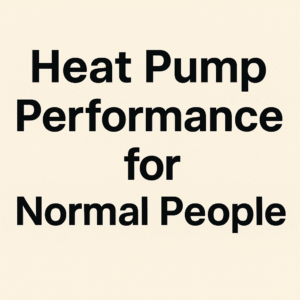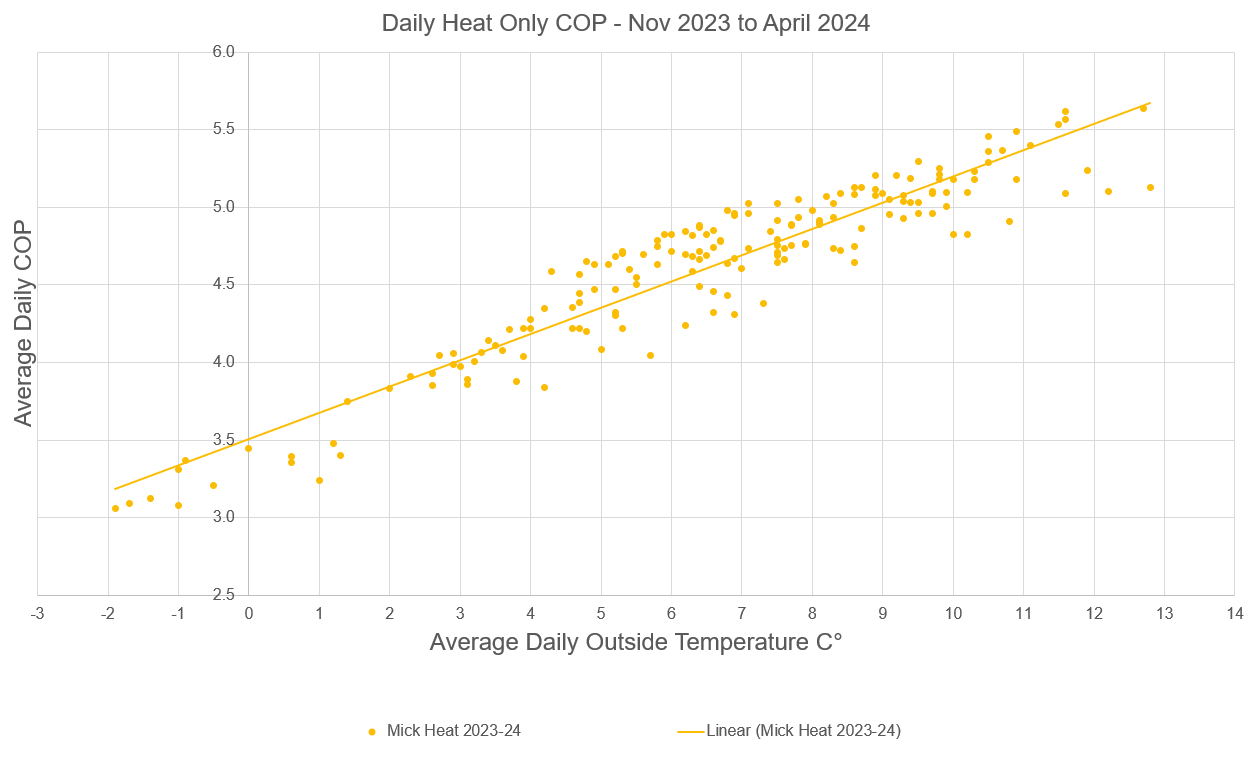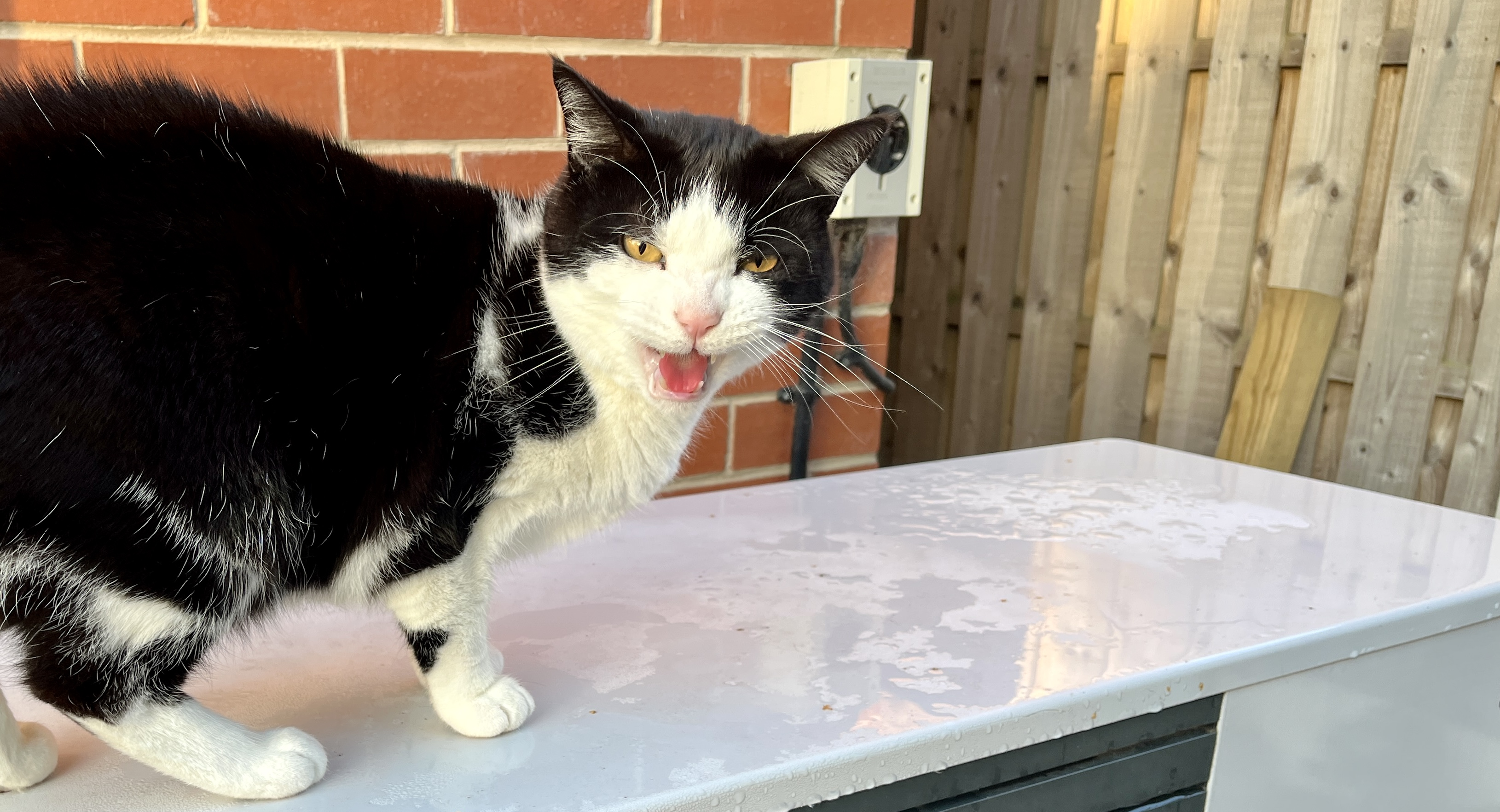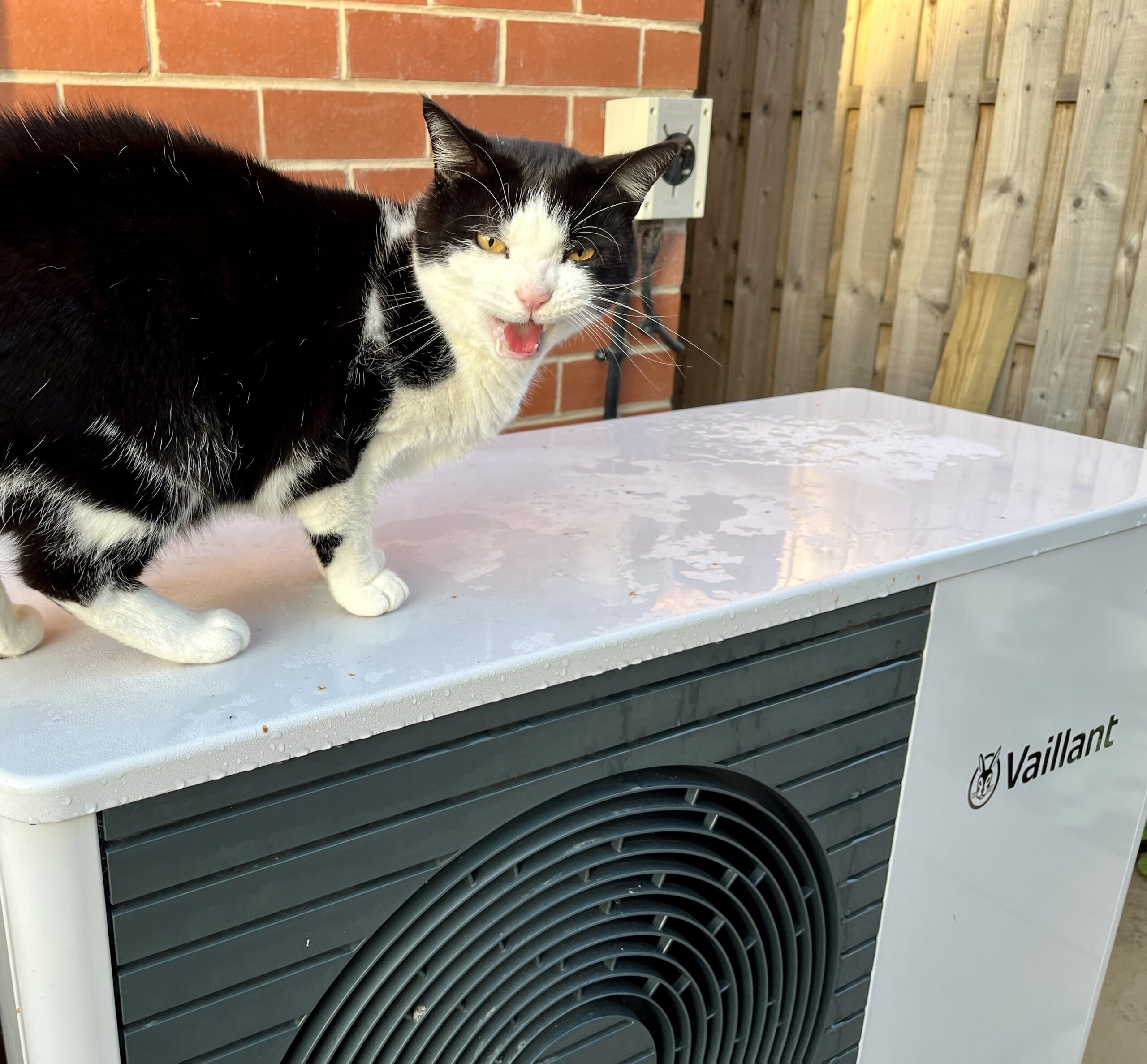Introduction
This is heat pump performance for normal people. If you have lived with a gas boiler, you will know the routine. It kicks in, blasts the radiators with very hot water at about 70 °C, then shuts off. The rads cool, the house cools, then it fires up again. On, off, on, off.
Now, to be clear, gas boiler systems can be set up to run at lower temperatures with weather compensation, and when they are, they can be more efficient than fixed, high temperature systems. The problem is that barely anyone runs them this way.
A heat pump system should not be designed and commissioned to run in this high-temperature, on/off way. In most cases, a gas boiler is more like a kettle. It fires up, blasts heat for a short burst, then switches off. A heat pump is more like a slow cooker. It ticks along steadily, keeping the house warm with lower temperature water and without the drama of big temperature swings.
And to clarify, when we talk about ‘flow temperature’, we mean how hot the water is that runs around your radiators or underfloor heating, coming from your heating system (whether that is a heat pump or a gas boiler). So a flow temp of 40 °C would mean the water in your radiators and underfloor loops is 40 °C.

Table of Contents
Why do heat pumps feel different to gas boilers?
With a boiler, radiators are often scorching hot for half an hour, then stone cold for the next. This has become the norm for most gas systems.
With a heat pump, you will notice radiators feel warm all the time, not burning hot. It is a different style of heating. The system is designed to run continuously, with water temperatures that rise or fall depending on how cold it is outside.
In the weather compensation example below, radiators sit at 40 °C when it is –3 °C outside and about 31 °C when it is 10 °C outside. They would never feel scalding, but the rooms stay a steady 20 °C. This is exactly what weather compensation does. Colder weather means warmer water into the radiators, and milder days mean cooler flow.
The car analogy helps. Imagine keeping your car at a steady speed. You can either floor the accelerator for a few seconds, then coast, then floor it again. Or you can hold a steady 50 mph. The majority of gas boilers are the first option. Heat pumps with weather compensation are the second.
Weather compensation for dummies
The clue is in the name. Weather compensation means the heating system knows what the weather is doing outside and adjusts itself to match.
If it is cold and frosty, the heat pump sends hotter water into the radiators. If it is mild, it sends cooler water. The goal is simple: always deliver just enough heat to keep the house steady at your target indoor temperature, without wasting energy. You are ultimately always trying to replace the heat being lost to the outside world at any given point in time.
Here is a simple example. Imagine a house with a 5 kW heat loss at –3 °C outside with a design flow temperature of 40 °C. As the outdoor temperature rises, the heat required falls, and so does the flow temperature:
| Outdoor Temp (°C) | Heat required (kW) | Flow Temp (°C) |
|---|---|---|
| –3 | 5.0 | 40 |
| 0 | 4.4 | 38 |
| 5 | 3.3 | 35 |
| 10 | 2.2 | 31 |
| 15 | 1.1 | 26 |
So at –3 °C outside, the house needs the full 5 kW and the heat pump supplies that with 40 °C water to the radiators or underfloor loops. By the time it is 15 °C outside, the house only needs 1.1 kW, and the flow temperature drops to just 26 °C.
Without weather compensation, the system would keep pumping out water at the same temperature no matter what. On a mild day, you would be overheating the house and wasting electricity. With weather compensation, the water temperature falls as the heat demand falls.
That is why radiators sometimes feel just lukewarm when it is mild outside. They do not need to be any hotter. The system is doing its job, matching supply to demand.
If you want to see the full detail of how Vaillant sets up these curves, I have written it all up in my Vaillant aroTHERM weather curve information guide.
Heat pump efficiency in plain numbers (COP/SCOP explained)
COP stands for Coefficient of Performance. It’s the ratio of heat your heat pump delivers compared with the electricity it uses to do that job. If your heat pump is producing 4 kWh of heat while using 1 kWh of electricity, the COP is 4.
You’ll also see the term SCOP, Seasonal Coefficient of Performance. Where COP is a snapshot at a given moment, SCOP is the average COP over a whole heating season, taking into account varying outdoor temperatures and different operating conditions. SCOP gives a truer picture of overall efficiency across the year, but it still depends heavily on system setup and how your home is run.
COP/SCOP is where the savings come in. Heat pumps are more efficient when they run at lower water temperatures.
Lower flow temperatures = higher COP/SCOP, which means you’re getting more bang for your buck.
Say your system is designed to run with water at 35 °C instead of 50 °C. The heat pump could deliver 20 to 30 percent more heat for the same amount of electricity. That is because the pump does not have to work as hard when the water is cooler.
Real world during the winter of 2023/2024: while my lowest daily COP was 2.87 on a freezing January day, across the full winter season my system delivered more than 4× the heat for every unit of electricity, and even went past COP 5 on days when it was over 10 °C outside.
This chart shows how my daily COP followed the outside temperature during that winter period. Cold days were less efficient, but the overall trend is clear: as the average outdoor temperature rose, efficiency climbed too.
This graphic is weather compensation and performance in a nutshell. Flow temperatures adjust based on the outside temperature and as such, COP improves as on warmer days because the flow temperature drops.

Living with a heat pump day to day (real world experience)
Comfort is different with a heat pump. Radiators will never feel boiling hot. They are more like a constant background warmth. Our family love this constant warmth. It is one of the advantages of a heat pump that you just cannot convey how good it is to people until they feel it for themselves.
Bills are different too. If you run your heat pump at unnecessarily high water temps, the efficiency tanks and your electricity bill rises. Keep it low and steady, and you will get the best performance, exactly what the efficiency numbers above show.
Real world during the whole of 2024: my system delivered 11,559 kWh of heat for 2735 kWh of electricity. That works out at a seasonal COP (SCOP) of 4.23. The split of heat output between heating and hot water looked like this:
-
Heating: 7877 kWh (68% of usage) – Heat only SCOP: 4.45
-
Hot water: 3682 kWh (32% of usage) – Hot water only SCOP: 3.84
We run our heat pump to deliver a constant 20 °C through the morning, day and evening, with a slight drop off overnight for more comfort whilst sleeping.
So setting your heat pump up with weather compensation and targeting just the right curve and temperature settings for your house comes with the added bonus of it being super comfortable and toasty.
Hot water performance with a heat pump
With a heat pump you need to preheat and store hot water in a cylinder. Just like heating the house, the lower the temperature you target, the better performance you can achieve.
But there is a balance to strike. You need to make sure there is enough hot water available for your household, and decide how frequently you want to heat it. Less spare capacity in the cylinder means you can run more efficiently, but it could reduce the hot water available for busy times.
Over the years I have tested countless settings and ended up with a few simple rules that I call the golden rules of efficient hot water generation with a heat pump:
-
Reheat from as empty or cold a cylinder as possible (set a high hysteresis) – no quick top-ups.
-
Choose the lowest target hot water temperature you can get away with.
-
Use Eco Mode (or another low compressor / quiet mode).
-
Schedule reheats when it is warmer outside.
-
The golden rule for the cheapest hot water runs: the money saved by scheduling reheats during the dip of an off-peak tariff will likely trump any efficiency gains.
I have explained these in detail after years of trial and error in my best heat pump hot water settings (the golden rules) article.
And if you are a Vaillant owner, the aroTHERM plus hot water modes document is another good starting point for making changes, alongside the golden rules.
Avoid third-party controls with a heat pump
Heat pumps work best when left to do their own thing. The system is designed around steady operation and weather compensation, not stop/start bursts.
Many homeowners are tempted to add “smart” controls like Hive or Nest, or to heavily zone their homes with thermostatic radiator valves (TRVs) or underfloor controls. Both approaches fight against how a heat pump should run. Heat pumps love lots of water to work with, what is known as an open loop design. If you start shutting down radiators, whole rooms or underfloor loops, you reduce the water volume in circulation and can cause the heat pump to short cycle. That hurts both comfort and efficiency.
Always use the manufacturer’s own controls for weather compensation. Don’t add third-party on/off thermostats as they disrupt how a heat pump should modulate and will hurt both comfort and efficiency. As Custom Renewables explain, this stop-start control method “can lower the heat pump’s efficiency and raise your energy bills.”
If you do struggle with fine-tuning the heat curve, there are even third-party online optimisers like Havenwise that can manage flow temperatures remotely and make the smart decisions for you. It is almost set-and-forget, but importantly it works with modulation rather than against it.
I have covered heat pump design and best practice in much more detail in my heat pump myths article.
Final thoughts on heat pump performance
At their core, weather compensated heat pumps are simple: they keep your home warm by matching heat output to what the house is losing, doing it steadily and efficiently. No big temperature swings, no drama. Just a comfortable background warmth that adapts with the weather.
The trick is in the setup. Get your weather compensation curve right, avoid fiddly third party controls that fight the system, and keep flow temperatures as low as you reasonably can. Do that and you will have a home that is both toasty and efficient.
And remember, efficiency is only half the story. Comfort matters just as much. For us, the steady warmth of a well-tuned heat pump has been a game changer
What to do next
If you already have a heat pump, or you are about to get one, the best thing you can do is understand how your system is performing and how to fine-tune it.
Here are some next steps and guides that will help:
-
Measure your COP and get a baseline of performance with my step-by-step guide: How to measure Vaillant aroTHERM COP
-
Learn how to adjust your weather compensation curve so your system output matches your house’s heat loss: Vaillant aroTHERM weather curve information
-
Choose the right controller settings for your home: sensoCOMFORT room temp mod inactive, active or expanded
-
Optimise your hot water strategy, because getting this wrong can hurt both comfort and performance: aroTHERM plus hot water modes
-
Follow my hot water golden rules to avoid common mistakes: The heat pump hot water golden rules
-
Save money by using the right time-of-use tariff:
Finally, you can find all these guides in one place for future reference: Vaillant aroTHERM heat pump guide.
Whilst these articles are Vaillant Arotherm focused, the core principals remain the same whichever heat pump you have.
Referral information and free credit offer
If you find the content of this website useful and are thinking of joining Octopus Energy, please consider using my referral code or ‘buy me a coffee’ to help support running costs of the website (hosting fees / cloud servers etc).
If you’re thinking of switching energy suppliers, homeowners that use this referral code can claim £50 of free Octopus Energy credit after sign-up: https://mickwall.octopus.energy
Business users that switch and sign-up using the same code with be granted £100 of free credit.
Get a £100 gift card when signing up for Solar or a Heat Pump installation through Octopus Energy using this link: https://tech.referrals.octopus.energy/ucMTeP8d
If you would like to ‘buy me a coffee’ to show support, please use this link: http://buymeacoffee.com/SVHgIbUYM
Energy Stats UK can be found on various social media platforms posting daily tariff pricing graphs and summaries.
Be sure to follow @energystatsuk on Twitter / X, Bluesky, Mastodon and Instagram.
Note: The current and past performance of energy pricing is not necessarily a guide to the future.






One Comment